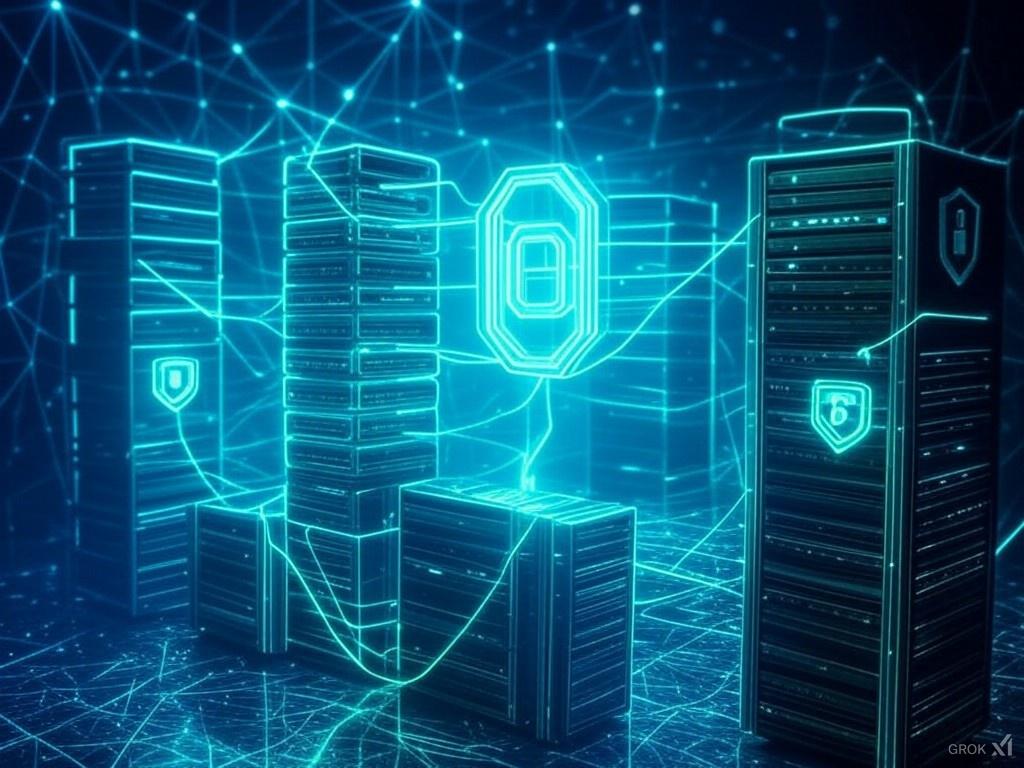 CaryptosHeadlines Media Has Launched Its Native Token CHT.
Airdrop Is Live For Everyone, Claim Instant 5000 CHT Tokens Worth Of $50 USDT.
Join the Airdrop at the official website,
CryptosHeadlinesToken.com
CaryptosHeadlines Media Has Launched Its Native Token CHT.
Airdrop Is Live For Everyone, Claim Instant 5000 CHT Tokens Worth Of $50 USDT.
Join the Airdrop at the official website,
CryptosHeadlinesToken.com

The Middle East’s financial sector is increasingly becoming a prime target for sophisticated cyberattacks. This surge in threats is driven by the widespread adoption of mobile financial services, online transactions, and emerging technologies such as artificial intelligence (AI) and cloud computing.
These advancements have expanded potential vulnerabilities, making financial institutions more susceptible to cybercriminals. According to the World Economic Forum’s Global Risks Report, cybersecurity has now emerged as one of the top five global threats over the next two years, with banking systems specifically highlighted as major targets.
The Pressure of Evolving Cybersecurity Demands
For cybersecurity professionals within the financial sector, the challenge is daunting. The rise of new data protection laws, including those being developed by the UAE Cybersecurity Council on cloud computing, Internet of Things (IoT) security, and cybersecurity operations centres, is pushing financial institutions to ensure robust protection for customer data. However, these regulations often lag behind the rapid pace at which cyberattacks are evolving, especially as AI-driven threats can outpace the time it takes for these regulations to be enforced.
The growing sophistication of cyberattacks—fuelled by advancements in AI—creates significant pressure on financial institutions. They must not only comply with new regulations but also secure their operations, reduce vulnerabilities, and preserve consumer trust. This is no easy task in an environment where attackers are continuously refining their tactics.
The Role of Regulations in Cybersecurity
Regulations play a crucial role in shaping the cybersecurity strategies of financial institutions, focusing largely on risk management. Yet, as the threats continue to evolve at lightning speed, regulations often lag behind, leaving organizations vulnerable in the interim.
Traditional corporate security teams are increasingly unable to prevent breaches quickly enough, with monitoring tools having limited ability to stop threats in real-time. Today, it takes cybercriminals far less time to compromise systems and exfiltrate data than it does for organizations to remediate those breaches—typically taking between four and six days.
The financial cost of such breaches is staggering, with the average data breach now costing around $4.45 million. To combat this, financial institutions need to adopt a proactive cybersecurity strategy, one that goes beyond merely complying with regulations. This includes investing in advanced technologies to rapidly detect and neutralize emerging threats.
Viewing regulatory requirements as a baseline for defense is crucial. While compliance is essential, it is not enough. In the financial sector, a proactive, threat-based strategy is vital for ensuring robust protection against cyber risks.
What About AI?
The is no doubt that Artificial intelligence is reshaping financial services, enhancing operational efficiency and customer experience. However, this transformative technology also introduces new cybersecurity risks. Cybercriminals are increasingly using AI for reconnaissance, social engineering, and developing malicious code, making attacks faster and harder to counter using traditional methods.
Ironically, AI is a double-edged sword in the world of cybersecurity. While organizations are leveraging AI to improve their security posture, cybercriminals are also using it to scale and automate attacks, making defense more challenging.
To tackle this, institutions must adopt AI-driven cybersecurity solutions that consolidate security products into a unified platform. This approach can help financial institutions detect and respond to threats in real time, protect data more effectively, and remain agile in the face of incoming regulatory changes.
Communicating Cybersecurity Needs
To successfully implement the right cybersecurity solutions, security teams must first gain the trust and investment of their organizations. Unfortunately, many C-level leaders in the financial sector tend to underestimate the significance of cyber-resilience. Therefore, it is essential for Chief Information Security Officers (CISOs) and Chief Technology Officers (CTOs) to communicate effectively about cybersecurity risks and the need for investment.
Maintaining trust is paramount for any organization handling sensitive or critical data. For financial institutions, whose reputations are closely tied to their customers’ trust, investing in cybersecurity is not just a necessity—it’s a strategic advantage.
Beyond reducing the risk of cyberattacks and their financial implications, robust cybersecurity measures can also help institutions unlock funds from their cyber insurance policies, further strengthening their financial resilience.
Blockchain Technology is the Answer
With these challenges in mind, blockchain technology emerges as a game-changing solution to tackle the growing cybersecurity threats facing the financial sector. Its transformative potential could reshape how institutions approach data security and risk management. Here’s how:
1. Enhanced Data Security and Integrity: Blockchain’s decentralized nature makes it an ideal solution for enhancing data security. In traditional systems, data is stored in centralized databases, making it a prime target for cybercriminals. However, blockchain stores data across a distributed network, making it much harder for attackers to compromise or manipulate the data. Each transaction is encrypted and linked to the previous one in a way that ensures the integrity of the entire chain. This level of security is particularly valuable in the financial sector, where protecting sensitive information, such as customer data and transaction records, is paramount.
2. Reduced Fraud and Cybercrime: The transparency and immutability of blockchain transactions make it difficult for cybercriminals to commit fraud. Since every transaction is recorded in a public ledger, it becomes nearly impossible for malicious actors to alter records without being detected. This can help financial institutions reduce fraudulent activities and improve accountability. Blockchain’s ability to provide traceable and verifiable records also makes it harder for hackers to cover their tracks.
3. Improved Authentication and Identity Management: Blockchain can improve authentication and identity management in the financial sector by providing a decentralized, tamper-proof system for verifying identities. Traditional identity management systems are vulnerable to hacks, where personal information can be stolen and misused. With blockchain, users can have more control over their personal data through cryptographic keys, allowing them to prove their identity without sharing sensitive information. This can significantly reduce the risk of identity theft and data breaches.
4. Smart Contracts for Automated Security: Smart contracts are self-executing contracts with the terms of the agreement directly written into code. These can be used to automate various security processes within financial transactions. For example, smart contracts can ensure that financial transactions are only processed if certain security criteria are met, or that access to financial services is granted only to verified users. By automating security protocols, blockchain can reduce human error and increase the efficiency of cybersecurity measures.
5. Securing IoT Devices: As the financial sector increasingly adopts the Internet of Things (IoT) for services such as digital payments and supply chain management, blockchain can provide a secure infrastructure for these devices. IoT devices are often targeted by hackers due to their vulnerabilities, but blockchain’s decentralized architecture and encryption can help secure communications between IoT devices, ensuring that data transmitted across networks is safe and tamper-proof.
6. Real-time Threat Detection and Response: Blockchain’s real-time, transparent nature makes it an effective tool for monitoring and detecting cybersecurity threats. By using blockchain to track transactions and security events in real time, financial institutions can identify suspicious activities and respond quickly. This can significantly reduce the time it takes to detect and mitigate cyber threats, which is crucial given the rapid pace at which attacks are evolving.
7. Strengthening Compliance and Auditing: Blockchain’s ability to provide an immutable and transparent record of transactions makes it a valuable tool for compliance and auditing. Financial institutions can use blockchain to create tamper-proof audit trails that meet regulatory requirements and provide real-time visibility into their operations. This can help reduce the risk of regulatory non-compliance and ensure that financial institutions are adhering to data protection and cybersecurity laws.
It is worth noting that the blockchain industry in the UAE is experiencing impressive growth, with an annual rate of 42%, as highlighted in the latest report by MarkNtel Advisors. This surge is driven by proactive government initiatives like the UAE Blockchain Strategy, which has positioned the country as a leader in embracing this transformative technology.
The national vision includes digitizing 50% of government transactions using blockchain by 2031, further accelerating the nation’s digital transformation.
In conclusion, the financial sector in the Middle East faces an escalating wave of cyber threats, amplified by the rapid adoption of emerging technologies like AI, cloud computing, and mobile financial services.
As cybercriminals become more sophisticated, traditional security measures struggle to keep up, demanding a shift toward more proactive strategies. Blockchain technology offers a transformative solution to these challenges, with its decentralized structure enhancing data security, reducing fraud, and improving identity management. By integrating blockchain into their cybersecurity frameworks, financial institutions can better protect sensitive data, respond to threats in real-time, and ensure compliance with evolving regulations.
With the UAE leading the way in blockchain adoption, the region is well-positioned to harness this technology to enhance financial security and drive its digital transformation forward.
In light of these advancements, the question remains: Will the financial sector fully embrace blockchain technology as the key to overcoming the growing cybersecurity challenges, or will traditional methods continue to dominate and eventually fail?











